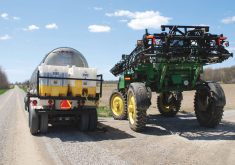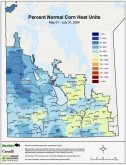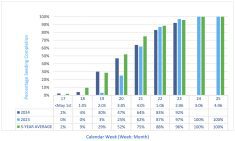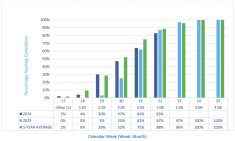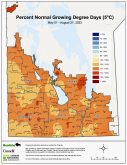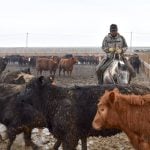Overview
Crop development has been rapid. Fungicide application in spring wheat for fusarium head blight is complete in most regions. Canola fungicide application continues in areas where disease potential is slightly higher. Corn growth continues to progress quickly and is approaching tasseling. Sunflower fields were mostly in the R2 (early bud) to R3 (early bud elongation) growth stages over the past week with the crop demonstrating rapid growth and good to excellent condition. Producers and agronomists continued assessing the need for fungicide applications as field peas continued to advance rapidly in the warm temperatures and relatively dry conditions. Low presence of disease in the lower crop canopy.
Cereals
Read Also
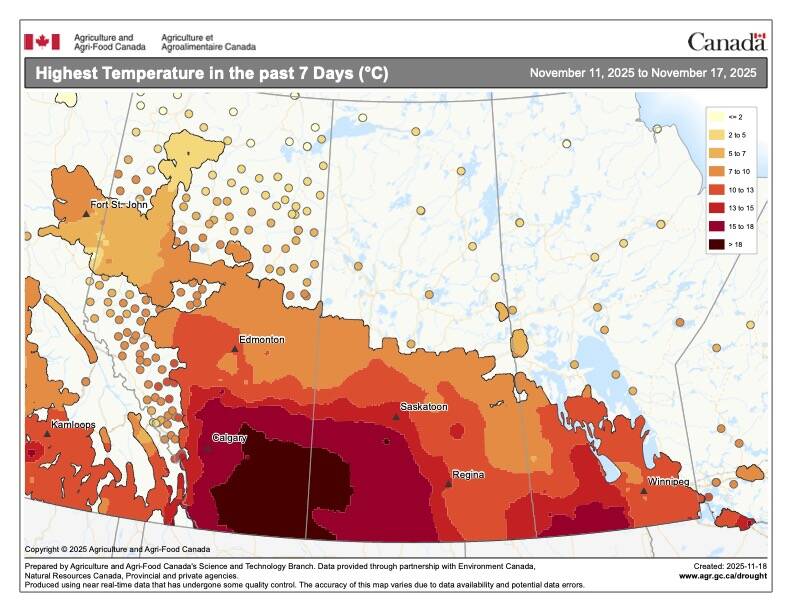
Farmer gift idea: How about a weather station?
The 2025 holiday season is looming, and a home weather station might make a great Christmas gift for farmers
Winter cereal crops ranged from hard dough growth stage to early dry down. If weather allows, harvest could begin in ten days to two weeks in some areas. Winter cereals remained in good to excellent condition.
Corn growth continues to progress quickly, and varies greatly depending on soil moisture and region. Staging ranges from V11 to VT (Tassel Emergence) stage.
Spring wheat is done flowering. The wheat crop is rated mostly fair to good.
Oilseeds
Canola ranges from 20 per cent to greater than 50 per cent flowering. The earliest seeded fields in early pod. In lower rainfall areas, growers remain concerned about uneven and stagey canola stands that are proving difficult to manage in terms of fungicide timing. Overall crop condition ranged from fair to good.
Canola fungicide application in the central region looks to be down from previous years with approximately 40 per cent of the acres being sprayed in the Central region.
Sunflower fields were mostly in the R2 (early bud) to R3 (early bud elongation) growth stages over the past week with the crop demonstrating rapid growth and is in good to excellent condition.
Flax crops moved to growth stage 8 (full flower) and plants in growth stage 9 (late flower) could be found in fields. The crop remains in good condition.
Pulses and soybeans
Field pea crops moved into the R4 (full pod) growth stage, with flat pods and a few remaining flowers also being found on plants. Producers and agronomists continued assessing the need for fungicide applications as field peas continued to advance rapidly in the warm temperatures and relatively dry conditions. Low presence of disease in the lower crop canopy.
Soybean growth stage ranged from full flower to beginning pod. Crop growth and development continued to be rapid in the warm weather.
Dry bean staging ranges from R2 to R3 growth stage.
Forages & livestock
Forages
Forage crops are cut and baled with the majority of first cut done. Crops are average to slightly below average due of the lack of moisture in some areas and insect damage in others. Rainfall is needed to bring on any regrowth.
Beef producers have completed first cut on approximately 85 per cent of tame hay and 70 to 75 per cent of native hay acres. Yields remain highly variable. Regrowth on hayfields is much slower and thinner due to the hot and dry weather conditions and increasing issues with salinity.
Grasshoppers are causing damage on some pastures.
Livestock
Cooler temperatures have given cattle some reprieve from the intense heat, however fly pressure continues to be strong.
Pastures are average to below average condition and are in need of moisture in the southwest. Pasture conditions are declining and significant rain is needed soon to sustain grazing for the summer.
Dugouts are about 70 per cent full in the Southwest.
Dugouts are approximately 30 per cent full in the Eastern region.
Regional comments
Southwest
The southwest saw another hot and dry week with no significant moisture. The dry conditions in several areas are starting to effect crop tillering and growth. Shoal Lake and Virden however, did receive 15 to 20mm of rain. Oak River and Rivers area had a major storm again with hail and some moisture. Damage to the crops for third or fourth time during this season in the area. Any precipitation is welcome and most areas in the region remain short for moisture. Rainfall in some areas has been very beneficial, but regular rains will be necessary to take crops to harvest. Growing degree-days and corn heat units are close to normal. Precipitation continues to be normal to below normal.
In general, crops look to be average, however they could slide into below average this week if rain does not arrive. Crops in the southern areas like Souris, Alexander, Reston, Melita, and Pierson look good generally. In northern areas like Hamiota, Kenton, Minnedosa, Neepawa, Shoal Lake are also looking good but need moisture to get the full potential. Birtle, and Alexander areas are very short in moisture.
Fall rye and winter wheat are filling well. Still reports of some cereal armyworms and grasshoppers damaging the crops so spraying is happening in some areas. Spring cereals are at flag leaf to the late anthesis stage, with some of the early seeded crops in head fill stage. Most of the fungicide application has been completed.
Most canola crops are flowering with the early seeded crops in full bloom. Several fields over the past week received a fungicide application.
Pea crops are flowering and in early pod development stage. Soybeans are at R1 to R3 stage. Crops look fair and are in need of rain at this point. Some late weed growth in areas where the stands are thin. Nodulation generally looks good.
Flax crops are in the early flower stage and crop is not as tall as normal. Sunflowers are starting to flower and handling dry weather good so far.
Northwest
A cooler week across the region with nighttime temperatures in the single digits. Ruthenia area was lowest for the region at 3 C. Most of the region received little to no precipitation but The Pas did receive 16 mm of rain. The week of moderate temperatures, and cloudy conditions helped keep the soil from drying out too much. Most of the region would benefit from precipitation. Localized thunderstorms brought some precipitation in the Swan Valley region with hail. Damage is unknown at this time.The main concern across the region continues to be the need for moisture, especially as the crops develop into grain filling.
Fall rye and winter wheat continue to advance nicely in the dough stages. Spring cereals continue to flower and advance into milk stage, while later seeded fields follow behind. Fungicide treatments continue as stages are reached. There are still few reports of armyworm in spring wheat requiring control as thresholds are reached. Oats and barley are heading/flowering. Some reports of grasshoppers requiring control in the Dauphin area.
The earliest seeded canola continues to pod, while the latest seeded canola range from the rosette stage through to flowering. Approximately 25 per cent of the canola is podding; 50 per cent flowering; 20 per cent bolting and 5 per cent rosette. Some fungicide applications are occurring as stages are reached.
Field peas are mostly looking good, however there are some fields that did not get timely rain and appear short. Growth stages are mostly at R3 and continuing to advance.
Soybeans are mostly at the R1 stage across the region. For the most part they look good, but in some areas that haven’t got adequate moisture they appear short. Some areas continue to see grasshopper activity picking up.
Central
Most areas remain very dry, but a few areas have adequate and even excess moisture. Thunderstorms this week brought some heavy rain and high winds to areas such as Holland which received 34mm of rain. Some storms brought hail, such as around La Salle, Bagot, MacGregor, and Portage. Producers in Newton, Oakville, and Elm Creek reported large hail, some larger than golf balls. Fields north of St. Claude, around Roland, and northwest of Winkler also received hail this past week.This has resulted in some lodged cereal crops and some defoliation in a variety of crops.
Fungicide applications are down this year compared to last year due to the lack of precipitation and the lower predicted yields making applications less economically viable. Fungicide application in spring wheat will see approximately 60 per cent of the acres being sprayed for fusarium head blight while in canola that number is approximately 40 per cent being sprayed.
Winter cereals are in the grain filling stage, with some very close to maturity. Spring cereals are at flowering to grain fill. Corn either is at, or just before tasseling and it continues to progress rapidly. Rainfall would be welcome at this stage as the plants are starting to show signs of stress by rolling their leaves to help conserve moisture.
Field peas are flowering and pod setting and flax is at the early flowering stage. Most soybeans are now flowering at the R3 stage. Still some issues with iron deficiency chlorosis and producers are concerned about nodulation in these areas.
Canola is flowering and starting to pod, with most canola around 40 per cent flowering, but canola ranges from 10 to 70 per cent flowering. Bud formation is beginning in sunflowers, with fields expecting to undergo rapid stem elongation this week.
Eastern
Accumulated rainfall varied from trace amounts to greater than 20 mm occurring as fast moving, mild to intense thunderstorms/showers. Central and southern districts generally received greater amounts of rain ranging from 10 to over 20 mm while northern districts saw trace to less than 10 mm of accumulation. Day and night time temperatures shifted to mostly below seasonal during the reporting period. Many producers would welcome additional rainfall over the coming weeks even if it slowed down their field activities. While crops remain in good condition overall, soil moisture reserves are not adequate to maintain crop condition unless recharged relatively soon.
Winter cereal crops ranged from hard dough growth stage to early dry down over last week. If weather allows, harvest could begin in 10 days to two weeks in some areas. Although winter cereals and grass forage seed crops remained in good to excellent condition overall, scouting for armyworms continued. There were fewer insecticide applications and the rapid advance of crop maturity is expected to reduce the need for control measures going forward.
Most spring cereal fields ranged from the end of flowering to the milk stage. Fusarium head blight fungicide applications were completed on most fields. Overall, cereal crops remain in fair to mostly good condition. Armyworm and grasshopper scouting continued in the crop although the number of insecticide applications was reduced compared to the previous week. Field by field insect scouting continues.
Corn growth stage ranged from V11 leaf stage to VT (tassel emergence) for the earliest seeded fields. The crop remained in good to excellent condition and demonstrated rapid growth in the warm weather.
Sunflower fields were mostly in the R2 (early bud) to R3 (early bud elongation) growth stages over the past week with the crop demonstrating rapid growth and good to excellent condition. Scouting for insects continued and low levels of sunflower bud moth were noted on some fields.
Most of the canola crop in the region ranged from 20 per cent to greater than 50 per cent flower with the earliest seeded fields in early pod. In lower rainfall areas, growers remained concerned about uneven and stagey canola stands that are proving difficult to manage in terms of fungicide timing. Overall crop condition ranged from fair to good. For those choosing to apply fungicides, spraying continued with some areas of the region up to 85 per cent complete and others less than 50 per cent done. Areas that received significant rainfall last week saw more fungicide applications occurring than originally planned as producers factored weather into their application decision. Insect scouting also became more widespread as fungicide applications were completed.
Flax crops moved to growth stage 8 and plants in growth stage 9 could be found in fields. Herbicide applications were complete. The crop remains in good condition.
Soybean growth stage ranged from R2 to mostly R3 (beginning pod) on most fields. Crop growth and development continued to be rapid in the warm weather. Overall crop condition remained good on most fields with the exception of some later seeded crop that remains stagey and thin due to poor topsoil moisture conditions at seeding time. Some reports of armyworms moving into soybean fields from adjacent cereal and grass forage seed fields.Plant defoliation levels remain low and monitoring continues. The presence of low levels of soybean aphids in some fields was noted and scouting continues.
Field pea crops moved into the R4 growth stage last week with flat pods and a few remaining flowers also being found on plants. Thus far, a very low presence of disease in the lower crop canopy has been found. The crop remained in good to excellent condition but growers were concerned about adequate soil moisture supply for the crop going forward.
Interlake
Rainfall continues to be variable with scattered thundershowers in the Interlake region. Southern areas and also in the Arborg area reporting dry conditions. Scattered showers for much of the region were reported in the South Interlake region. Highs for daytime temperatures ranged from 28 to 29 C this past week. Minimum overnight temperatures dropped, ranging between 2.5 to 7.5 C.
Most corn is close to tasseling. In the driest areas, silage corn is losing its green colour. Cereals have rapidly advanced, and most crops are 70 per cent headed or heading. Fungicide applications for fusarium head blight in wheat are wrapping up.
Most crops are shorter than normal, and majority of crops have suffered from dry conditions and insect pressure. Uneven germination is evident in all crops; most crops are stagey. Peas and flax have fairly even stands and are developing well. Flax is at flowering stage, most fields are on the short side. Peas also shorter than normal, and in full flowering stage and most fungicide applications are complete.
Fungicide application by air and ground to reduce the impact of sclerotinia in canola is well underway. Some producers reported that acres treated are much lower than normal due to dry conditions.




